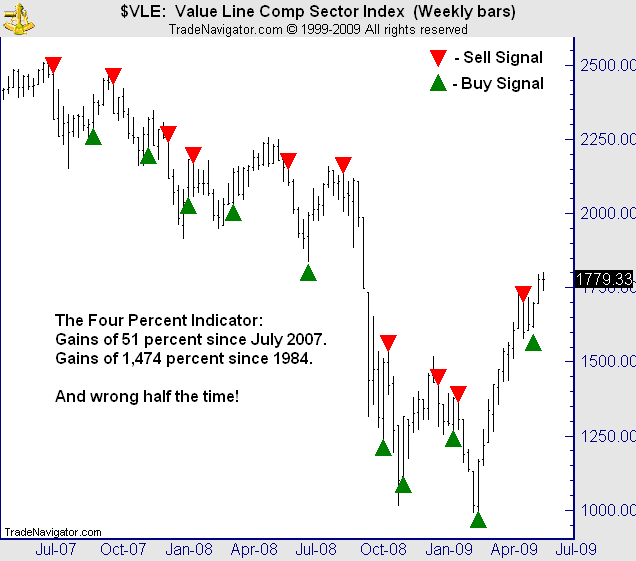Whipsawed? One good trend pays for them all!
No approach to trading avoids all losses, but good approaches minimize losses, maximize gains, and produce net profits over time. The approach of Ed Seykota has been a notable success. The “Whipsaw Song” is a fun introduction to his trend-following approach.
Know when to hold and when to fold with the Four Percent Indicator
The Four Percent Indicator guides you to being invested in all major market moves and has produced big gains over the past 25 years. An investment of $100,000 based upon the Four Percent Indicator would have increased to $1,574,162.05 over the past 25 years, a gain of 1474 percent.
The approach is simple and effective, but requires discipline to achieve success because short-term swings that exceed four percent produce losing periods. In addition, as is common with many effective market timing systems, the approach produces more losing than winning signals. Only 42 percent of the 115 signals over the last 25 years have produced gains. However, the winning signals have consistently exceeded the losses of the losing signals and generated big profits over time.
You can examine the performance of the last 115 completed signals of the Four Percent Indicator in the Value Line Arithmetic Index from the buy signal of August 3, 1984 through the latest buy signal of May 29, 2009 by clicking here.

Four Percent Indicator Buy and Sell Signals
The approach gives a buy signal when the weekly close of the stock market is four percent above low points (local minima) and a sell signal when the weekly close is four percent below high points (local maxima). For example, the Value Line Index closed at a low point of 1016 on March 6, 2009. The index closed more than 4 percent higher the next week on March 13th, producing a buy signal. That buy signal remained in effect until the index closed down more than 4 percent on May 15th from the closing high of May 8th. The sell signal from that decline was reversed when the market closed up on May 29th more than 4 percent above the May 15th closing low.
Ned Davis developed the Four Percent Indicator based upon the Value Line Composite Index. Martin Zweig popularized its use in his 1986 book Winning on Wall Street.
Very few investors make more money in the stock market than anyone using the Four Percent Indicator could make. Very likely, you would be richer today if you had followed this approach from the first year that you began investing.
You can’t change the past, but you can change your investing future. The Four Percent Indicator is a simple tool that you can use to build a financially sound future. Look at the numbers and see for yourself.
 Financial markets are predictable because segments of price action fit together in a limited number of patterns that are not random. Markets are unpredictable too because there is enough variability in the patterns to hide the trend at some stages of development. I am fascinated by the market and spend a lot of time working to identify price trends so I can exploit them for profit.
Financial markets are predictable because segments of price action fit together in a limited number of patterns that are not random. Markets are unpredictable too because there is enough variability in the patterns to hide the trend at some stages of development. I am fascinated by the market and spend a lot of time working to identify price trends so I can exploit them for profit.